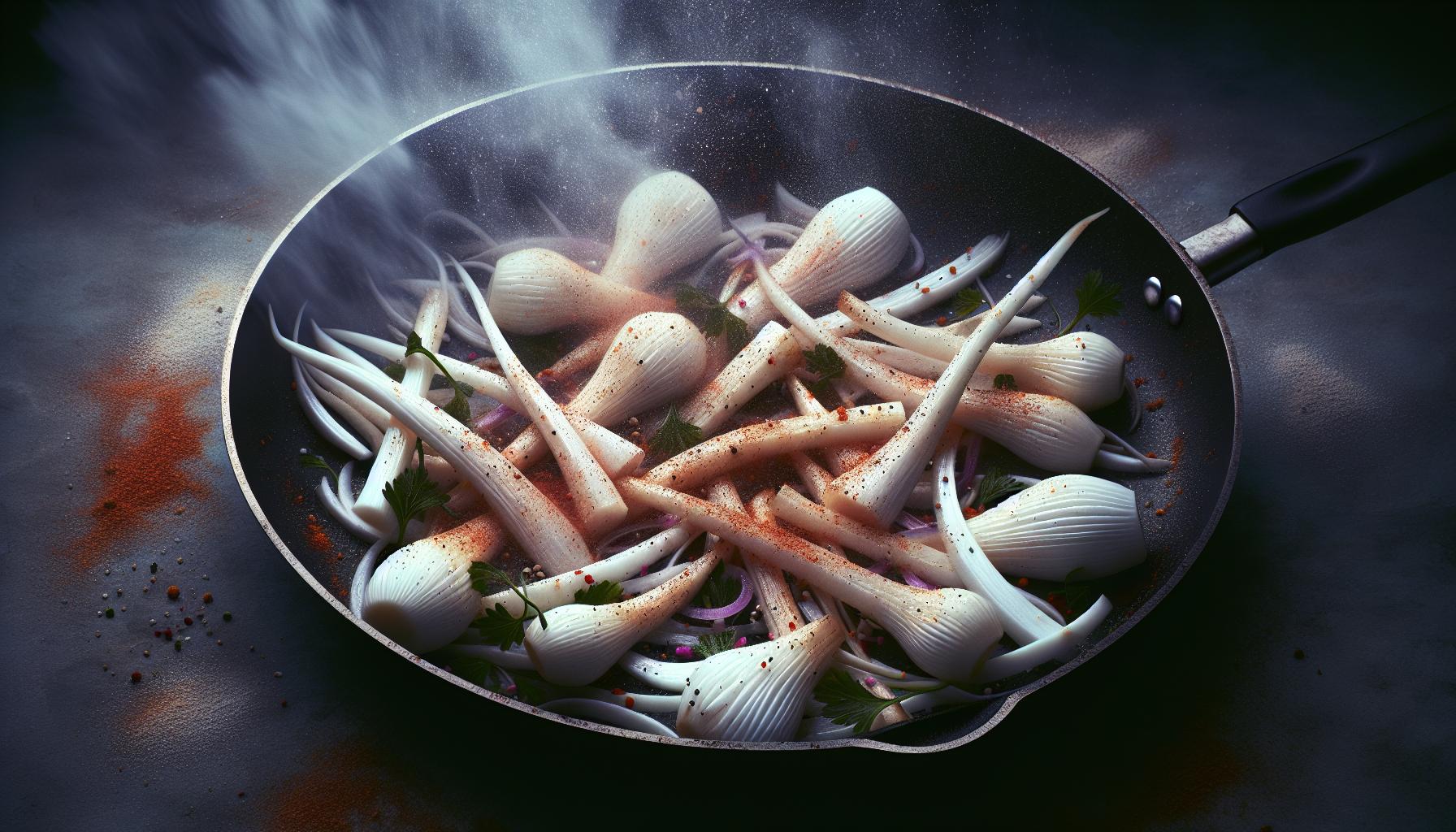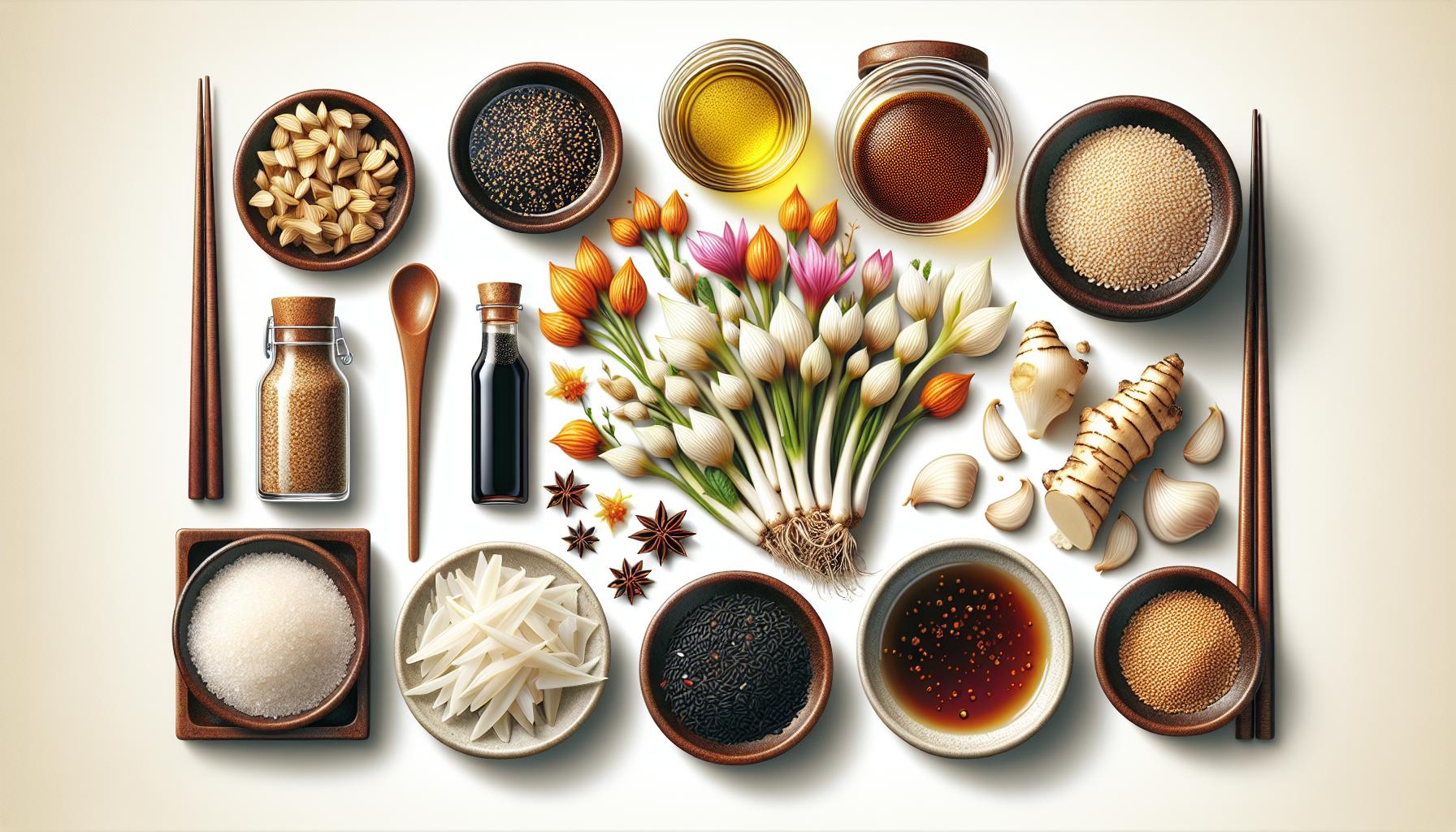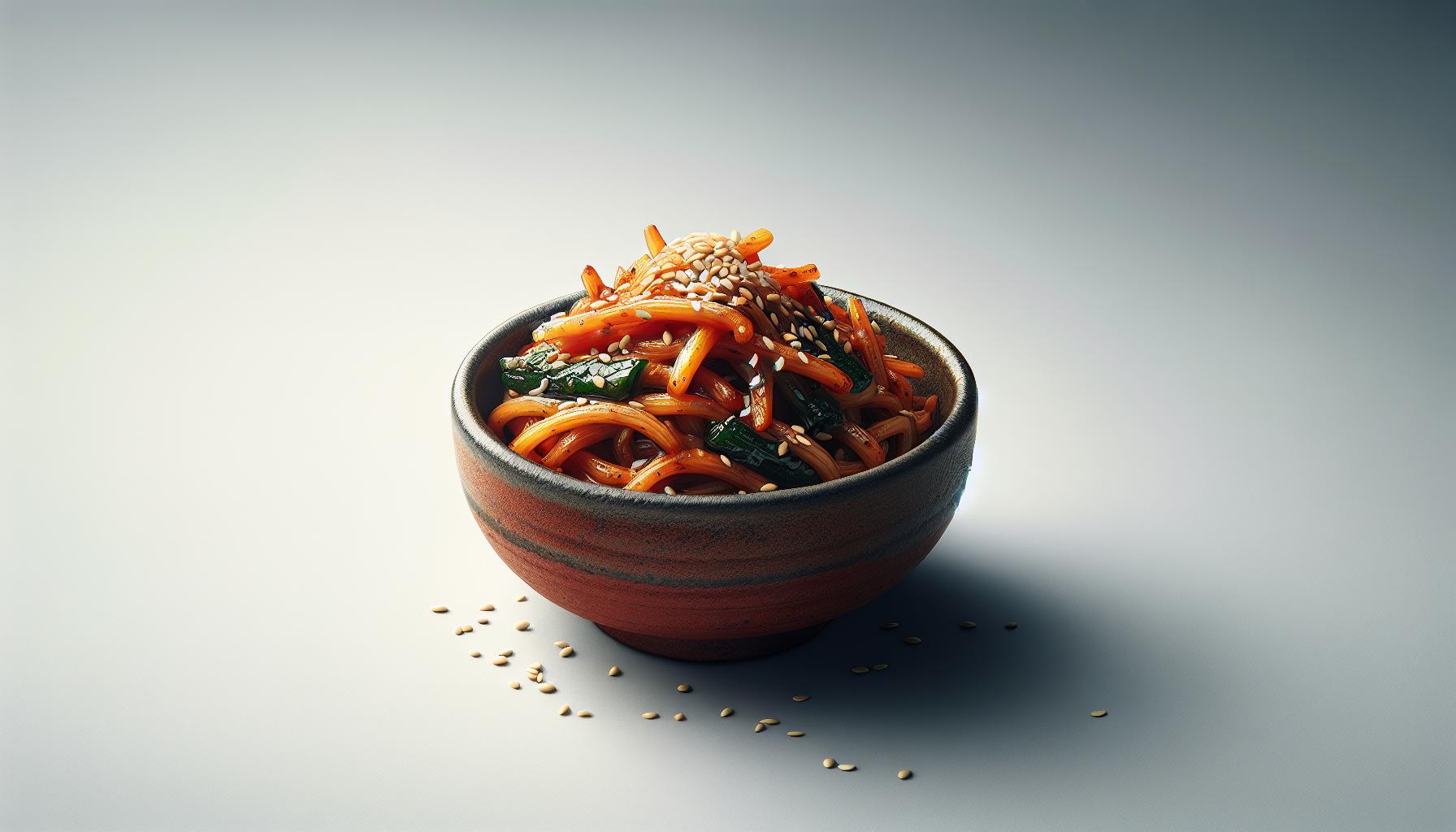Benefits of Doraji Namul
In your journey of exploring Korean cuisine, you’ve unquestionably heard the praises sung of Doraji Namul. Beyond its compelling taste, the dish boasts a host of health benefits that would impress even the most health-conscious eater.
Bellflower roots, the hero ingredient in Doraji Namul, are loaded with saponins. Saponins are phytochemicals known to boost your immune system and lessen the risk of heart disease.
Let’s dive into the nitty-gritty details of the nutritional advantages derived from these humble roots.
Providing a Low-Calorie Option
Doraji namul shines as a low-calorie dish. A perfect choice when you’re mindful of weight control yet unwilling to compromise on taste.
Packed with Dietary Fiber
Bellflower roots are a great source of dietary fiber. If you’re constantly seeking solutions for maintaining gut health, incorporating Doraji Namul into your meals is a great choice. A well functioning digestive system can do wonders for your overall health.
Rich in Vitamins and Minerals
Talk about nutritional powerhouses, and you can’t leave Doraji Namul out. These roots are packed with essential vitamins and minerals. The most notable are Vitamin C and abundant minerals like potassium and calcium.
Take note of the breakdown of the nutritional data for Doraji Namul per serving:
| Nutritional Element | Amount |
|---|---|
| Calories | 42 |
| Carbohydrates | 10g |
| Protein | 1g |
| Vitamin C | 20% of Daily Value |
| Dietary Fiber | 3g |
This gem, hidden in the pantry of Korean households, holds a special place in their heart not just for its flavor but also for its significant health benefits. As you embark on your quest to create Doraji Namul at home, remember, it’s more than just a dish. It’s a flavorful road to enhanced well-being. So, ready to give it a go?
Ingredients You’ll Need

To make your own delicious Doraji Namul at home, gather these essential ingredients. Remember, the flavor profile is flexible so feel free to adjust quantities according to your liking or dietary preferences.
Doraji or Bellflower Roots Preparation
- Fresh Doraji or Bellflower roots: 300 grams. In case you don’t have fresh ones, use dried 150 grams and soak them in water for a few hours until they’re rehydrated. Fresh roots give the best flavor but dried ones can be a handy substitute.
- Soy Sauce: About 2 tablespoons to add a savory depth to the dish.
- Sesame Oil: A generous 1 tablespoon drizzle for the perfect fragrance and flavor.
- Fine Sugar: Roughly 1 tablespoon to balance out the savory with a hint of sweetness.
- Garlic: 2 cloves, minced, for that essential tang.
- Green onions: 2 tablespoons, finely chopped are enough to add a mild hint of spice.
- Red pepper flakes (Gochugaru): A dash, about 1/2 teaspoon, provides a subtle but noticeable kick. If you’re looking to keep it mild, feel free to adjust this quantity.
On a nutritional note, consuming Doraji Namul means you’re tapping into its rich dietary fiber content, vitamin C, potassium, calcium, and more. Have a look below at how these ingredients further contribute to the meal’s nutritious capacity.
| Ingredient | Quantity | Calories | Carbs | Protein | Fat |
|---|---|---|---|---|---|
| Bellflower Roots | 300 g | 81 | 19.09 | 1.8 | 0.5 |
| Soy Sauce | 2 tbsp | 17 | 2.6 | 1.3 | 0.1 |
| Sesame Oil | 1 tbsp | 120 | 0 | 0 | 14 |
| Sugar | 1 tbsp | 48 | 12.57 | 0 | 0 |
| Garlic | 2 cloves | 9 | 2 | 0.4 | 0 |
Step-by-Step Cooking Instructions

Now that you’re armed with knowledge about the health benefits and ingredients, it’s time to dive into the heart of the matter: the actual cooking process for Doraji Namul. Although it might look daunting, stick with it – you’ll love the results!
Preparing the Bellflower Roots
Start with 250 grams of fresh or dried bellflower roots. For fresh roots, clean them thoroughly, peel off the skin, and slice into thin pieces. For the dried ones, soak in water overnight for rehydration and then cut into slices.
The Actual Cooking
- Boil a pot of water (about 4 cups). Add the root slices and boil for about 20 minutes.
- Drain the boiled roots but save 2 cups of the hot water to use later.
- Let’s now create the seasoning. Mix 2 tablespoons of soy sauce, 1 tablespoon of sesame oil, 1 teaspoon of sugar, 2 cloves of minced garlic, and 2 chopped green onions.
- Heat up a pan and add the drained bellflowers.
- Utilizing that savory seasoning, we just made, add it to the pan.
- Stir and mix to ensure the bellflowers are evenly coated, then add the saved hot water.
- Let it simmer on low heat for about 10 minutes until the flavored water is absorbed into the roots.
Tip: For an extra punch of flavor, you might want to add 1 tablespoon of chili flakes.
For those health-conscious folks out there, here is some of the nutritional data of the finished dish:
| Nutrient | Quantity Per Serving |
|---|---|
| Calories | 78 |
| Protein | 1.5g |
| Carbohydrates | 15g |
| Fat | 2g |
| Vitamins A & C | 35% DV |
With this, you’re pretty much done cooking your Doraji Namul. The dish is normally served chilled, so you’d want to let it cool or refrigerate it for a few hours before munching down. For those who are a bit more adventurous in the kitchen, you can potentially utilize this versatile dish as a side component in a larger Korean-style banquet. Let’s see how that would turn out!
Tips for Cooking Doraji Namul

Leveraging the Right Ingredients
When experimenting with your Doraji Namul recipe, it’s the ingredients that can truly make a difference. The ingredients you choose should sing harmonies in your dish.
- Bellflower Roots
Whether you’re using fresh or dried bellflower roots, ensure they’re thoroughly cleaned. - Sesame Oil
Don’t underestimate the power of quality sesame oil! This ingredient adds a rich, toasty undertone to the dishes it graces. It’s worth investing in a high-quality variant. - Soy Sauce
All soy sauces are not created equal! Using a premium, naturally brewed soy sauce can significantly enhance the depth of flavor in your Doraji Namul.
Uncommon Ingredient Suggestions
Doraji Namul is flexible and you’re welcome to add a personal twist to it. Here are some ingredient additions that might just elevate your dish:
- A sprinkle of white sesame seeds
- Add a hint of sharpness with some rice vinegar
- Some freshly grated ginger for an earthy zing
Finally, let’s quickly address the important aspect of nutrition. Here’s the estimated nutritional breakdown for a single serving of homemade Doraji Namul.
| Nutrient | Amount per serving |
|---|---|
| Calories | 80 kcal |
| Proteins | 2g |
| Fats | 4g |
| Carbs | 10g |
| Vitamins | Vitamin C, E |
Every ingredient in your Doraji Namul contributes to these numbers. So which version of Doraji Namul you wish to create today, dear home cook — the classic one or the one with your signature twist? Cooking is, after all, an expression of your creativity.
Serving and Enjoying Doraji Namul

After your doraji namul is beautifully prepared, you may wonder the best way to serve and enjoy it. Here’s how! Your edible masterpiece should typically be served at room temperature. It’s the traditional way to appreciate it. However, you’re allowed the liberty to tweak things up a bit. If you prefer it slightly chilled, feel free to pop it in the refrigerator for a few minutes before serving.
When it comes to presentation, small details make a big difference. Try serving doraji namul in a small, deep dish. Let the bellflower roots take center stage. You can add a sprinkle of toasted sesame seeds and a final drizzle of sesame oil to accentuate their earthy flavors. But don’t go overboard. Remember, it’s about enhancing, not masking the bellflowers’ unique taste.
One beautiful thing about doraji namul is that it’s versatile. As a banchan, it gets along pretty well with most Korean dishes. Whether it’s a hot sizzling plate of bulgogi or a warm bowl of bibimbap, doraji namul adds a refreshing touch.
Part of the joy of preparing doraji namul is the opportunity to branch out and get creative. Perhaps you could pair it with a spicy kimchi or a sweet and crispy japchae. What about serving it with grilled meats or fish? The options are endless, and the choice is yours. So, don’t hesitate to make variations based on your preference.
And don’t forget, while savoring every bite of doraji namul, consider its impressive nutritional profile. Packed with vitamins, low in calories, and flavored with healthy ingredients, it offers a perfect balance of taste and health. So go on, indulge guilt-free.
Conclusion
So, you’ve journeyed through the art of preparing homemade Doraji Namul, the sauteed bellflower roots dish that’s as nutritious as it’s delicious. It’s a dish that’s not just about flavor, but also presentation, with bellflower roots taking center stage, adorned with sesame seeds and oil. It’s a versatile companion to your favorite Korean dishes, be it bulgogi, bibimbap, or even a simple side of kimchi or japchae. And let’s not forget the health perks – it’s a vitamin-rich, low-calorie dish, made with all things good for you. Now, it’s your turn to bring this traditional Korean dish to your table. Experiment, enjoy, and let Doraji Namul add a touch of Korean flair to your meals.

